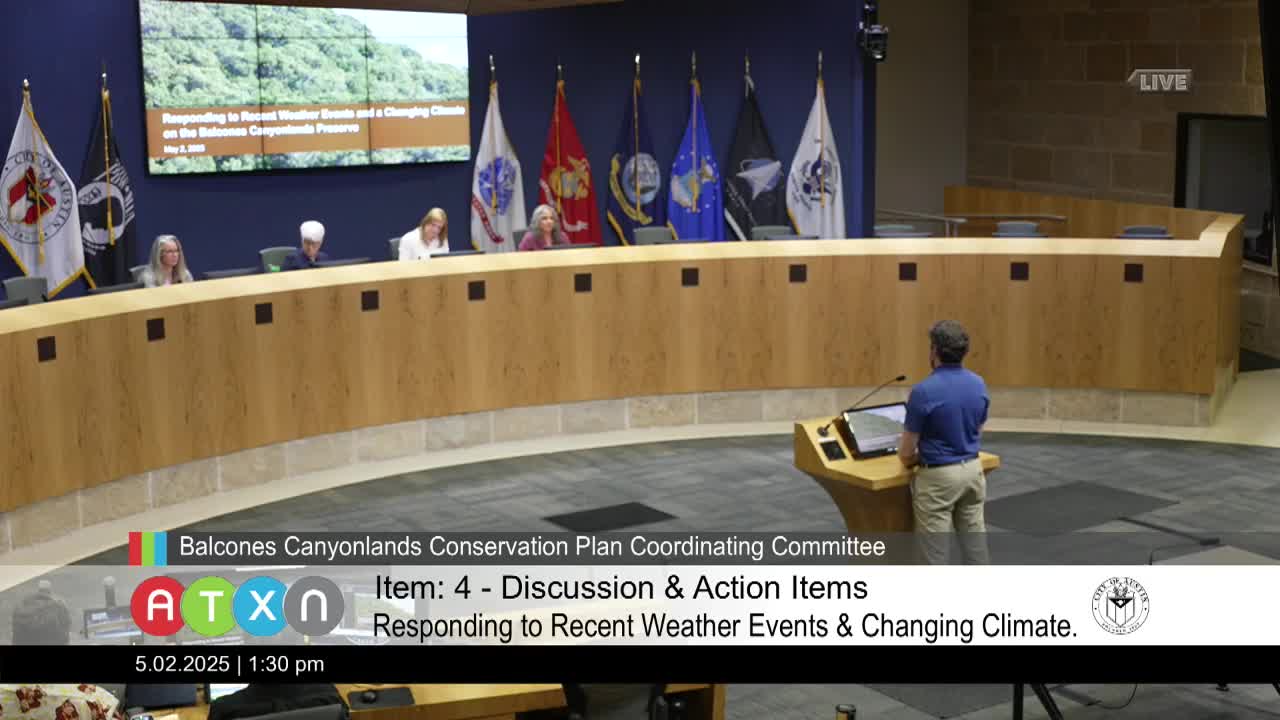Travis County discusses wildfire risks and climate impacts amid drought and winter storms
May 02, 2025 | Austin, Travis County, Texas
This article was created by AI summarizing key points discussed. AI makes mistakes, so for full details and context, please refer to the video of the full meeting. Please report any errors so we can fix them. Report an error »

In a recent meeting of the Austin Balcones Canyonlands Conservation Plan Coordinating Committee, members discussed the pressing environmental challenges facing the region as it heads into summer. The conversation highlighted the impacts of recent weather events, including winter storms and droughts, and how these factors influence land management strategies and public awareness.
Over the past three decades, Austin has developed an extensive network of open spaces, which serves as a vital resource for residents and wildlife alike. This network not only meets the habitat needs of specific species but also provides a protective umbrella for diverse ecosystems. The committee emphasized that maintaining large, contiguous natural areas enhances resilience against environmental disturbances, allowing nature to recover more effectively from shocks.
However, the growth of Austin and Travis County has led to increased development near these natural preserves, raising concerns about the wildland-urban interface. Residents are increasingly witnessing the effects of winter storm damage and drought conditions, prompting fears about potential wildfire risks similar to those seen in other regions, such as California. Despite these concerns, committee members reassured the public that the local climate and vegetation differ significantly from those in Southern California, resulting in a lower overall wildfire risk.
A study conducted in the mid-2000s by Dr. White from Baylor University revealed that while wildfire risks exist, they are primarily caused by human activity rather than natural ignitions. The committee noted that most wildfires in the Balcones Canyonlands have been linked to human actions, particularly in developed areas. The resilience of local woodlands, characterized by moist juniper and oak trees, typically prevents fires from spreading rapidly.
As the region faces the possibility of another severe drought, the committee is focused on understanding the impacts of these environmental changes. They are collaborating with the U.S. Forest Service to update previous studies on wildfire fuels, aiming to quantify how droughts and winter storms have altered the landscape. This research is crucial for developing effective management strategies that promote healthy and resilient ecosystems.
The discussions underscored the importance of proactive engagement with the community regarding wildfire risks and environmental changes. As conditions evolve, the committee remains committed to fostering a deeper understanding of these challenges and enhancing the resilience of the Balcones Canyonlands. The meeting concluded with a call for continued collaboration and public education to address the ongoing environmental concerns facing the region.
Over the past three decades, Austin has developed an extensive network of open spaces, which serves as a vital resource for residents and wildlife alike. This network not only meets the habitat needs of specific species but also provides a protective umbrella for diverse ecosystems. The committee emphasized that maintaining large, contiguous natural areas enhances resilience against environmental disturbances, allowing nature to recover more effectively from shocks.
However, the growth of Austin and Travis County has led to increased development near these natural preserves, raising concerns about the wildland-urban interface. Residents are increasingly witnessing the effects of winter storm damage and drought conditions, prompting fears about potential wildfire risks similar to those seen in other regions, such as California. Despite these concerns, committee members reassured the public that the local climate and vegetation differ significantly from those in Southern California, resulting in a lower overall wildfire risk.
A study conducted in the mid-2000s by Dr. White from Baylor University revealed that while wildfire risks exist, they are primarily caused by human activity rather than natural ignitions. The committee noted that most wildfires in the Balcones Canyonlands have been linked to human actions, particularly in developed areas. The resilience of local woodlands, characterized by moist juniper and oak trees, typically prevents fires from spreading rapidly.
As the region faces the possibility of another severe drought, the committee is focused on understanding the impacts of these environmental changes. They are collaborating with the U.S. Forest Service to update previous studies on wildfire fuels, aiming to quantify how droughts and winter storms have altered the landscape. This research is crucial for developing effective management strategies that promote healthy and resilient ecosystems.
The discussions underscored the importance of proactive engagement with the community regarding wildfire risks and environmental changes. As conditions evolve, the committee remains committed to fostering a deeper understanding of these challenges and enhancing the resilience of the Balcones Canyonlands. The meeting concluded with a call for continued collaboration and public education to address the ongoing environmental concerns facing the region.
View full meeting
This article is based on a recent meeting—watch the full video and explore the complete transcript for deeper insights into the discussion.
View full meeting
